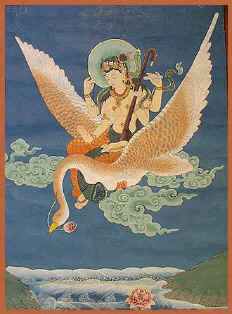-
http://www.abuddhistlibrary.com
Saraswati appears as a Buddhist yidam in her capacity as embodiment of culture, learning and the arts, especially music. Her mythology also includes an important purificatory aspect. In many regards, she shares characteristics with White Tara.
 In Tibetan, Saraswati is Yang Chenmo, or when her musical aspect is emphasized, she is Piwa Karpo. In Mongolian she is Keleyin ukin Tegri, in Chinese she is called Tapien-ts'ai t'iennu or Miao-yin mu, and in Japan she is equated with Benten. The Tibetan singer Yungchen Lhamo is named for Saraswati.
In Tibetan, Saraswati is Yang Chenmo, or when her musical aspect is emphasized, she is Piwa Karpo. In Mongolian she is Keleyin ukin Tegri, in Chinese she is called Tapien-ts'ai t'iennu or Miao-yin mu, and in Japan she is equated with Benten. The Tibetan singer Yungchen Lhamo is named for Saraswati.
She is often identifiable by her plain white garment, (though not in this image) her veena which is a stringed musical instrument, and her association with the consonants and vowels of the Sanskrit language. Her own seed syllable is haym.
In the Sadhanamala (162) Maha-Sarasvati's mantra is:
Om Hrih Mahamayange Mahasarasvatyai namah.
In Hinduism, she is the daughter of Durga and wife of Lord Brahma, and her vehicle is the celestial bird called the hamsha or kinnara, today portrayed as a swan but sometimes a peacock. She is called Sharda Devi or Sharada (Sarada) and the hymn to her says that her home is Kashmir, once famous for its pandits or learned scholars.
Om Hrih Mahamayange Mahasarasvatyai namah.
In Hinduism, she is the daughter of Durga and wife of Lord Brahma, and her vehicle is the celestial bird called the hamsha or kinnara, today portrayed as a swan but sometimes a peacock. She is called Sharda Devi or Sharada (Sarada) and the hymn to her says that her home is Kashmir, once famous for its pandits or learned scholars.
Saraswati means 'the one that flows' and is the name of a Vedic river that once flowed, but has vanished. That is the source of her connection with fluidity of all fertile kinds including speech, writing, song, music and thought. She is also known as Vak [speech.]
In India, grandmothers make a pentagram or Saraswati-sign with honey
on the tongue of newborns to invoke the blessing of speech.
on the tongue of newborns to invoke the blessing of speech.
Hers is a spring [besant] festival falling on the fifth day of the new year's waxing moon. In Bengal, it is the custom of girls to wear the light orange shade called besanti on Saraswati Day.Students of all kinds call upon her for success in their studies. She is depicted dressed in pure white without the usual adornments of goddesses as she, herself, is the source of illumination.
In Bengal, students are supposed to fast before the Book or Boi Puja as this time is also known, and writing materials, musical instruments and school supplies are placed before the deity's altar.Books are considered sacred to Saraswati; if one accidentally sits or puts their feet on even a page of a book, it is necessary to pranam [bow with palms together] or touch it to the forehead with respect, as a form of apology for the misdeed.Offerings end with a special floral and fruit tribute [pushpanjali] accompanied by the following mantra said three times:Saraswati maha-bhage vidye kamala lochane
Viswa-rupe vishalakshi vidyangdehi namastute
Esho shachandana pushpa bilvapatranjali
Namo Saraswatvayi devyayi namo.This puja is also the time that very young children are initiated into writing. An elder holds the child and guides its hand to write for the first time, the first letter of the Sanskrit alphabet - Aum.
In Bengal at least, this festival is celebrated in all schools and colleges, and educational institutes are closed all day. Children participate feeling this will bring them luck in their exams.
Saraswati Puja is also plum-eating day. Amusingly to English-speakers, in Bengali the word for the fruit that epitomizes spring is Kool.~ Source of Saraswati Puja in Bengal: Biswas Anirban, Calcutta.
In Buddhism, as well as being a yidam or inspirational deity Saraswati is sometimes considered the consort of Manjushri, the knowledge bodhisattva. She was the yidam of the reformer and founder of the lam-rim system, Tsongkhapa.
Mipham Rinpoche invokes Saraswati in the introduction to The Blazing Lights of the Sun and Moon [Sherab Raltri]:
In the expansive lotus-garden of speech of all the conquerors,
With 100,000 melodious blooms of holy Dharma,
You are a singing swan that shines as bright as moonlight,
May you now enjoy the vast lake of my mind.
Sometimes considered the peaceful form of Palden Lhamo, which may derive from the connection with Nila Saraswati, a dark blue emanation of [Durga] the Mahakali of Hindu tantric tradition,Yangchenma is sometimes associated with White Tara since she is white with one face and, sometimes, three eyes. She can be depicted with only two hands, knees bent with crossed ankles as she sits playing her instrument, but often with four when one holds a book of scripture and one a mala - the mala symbolizes the string of letters of the alphabet.
There is also a red Sarasvati - Yangchen Marmo and a vajra or Dorje Yangchenma.
The mantra of her form as Arya Vajrasarasvati (sadhanas no.161 & 163) is:
Om, pichu pichu prajna vardhani jvala jvala medhavardhani dhiri dhiri
buddhivardhani, Svaha
buddhivardhani, Svaha
~ mantra information courtesy M. B., Nepal

